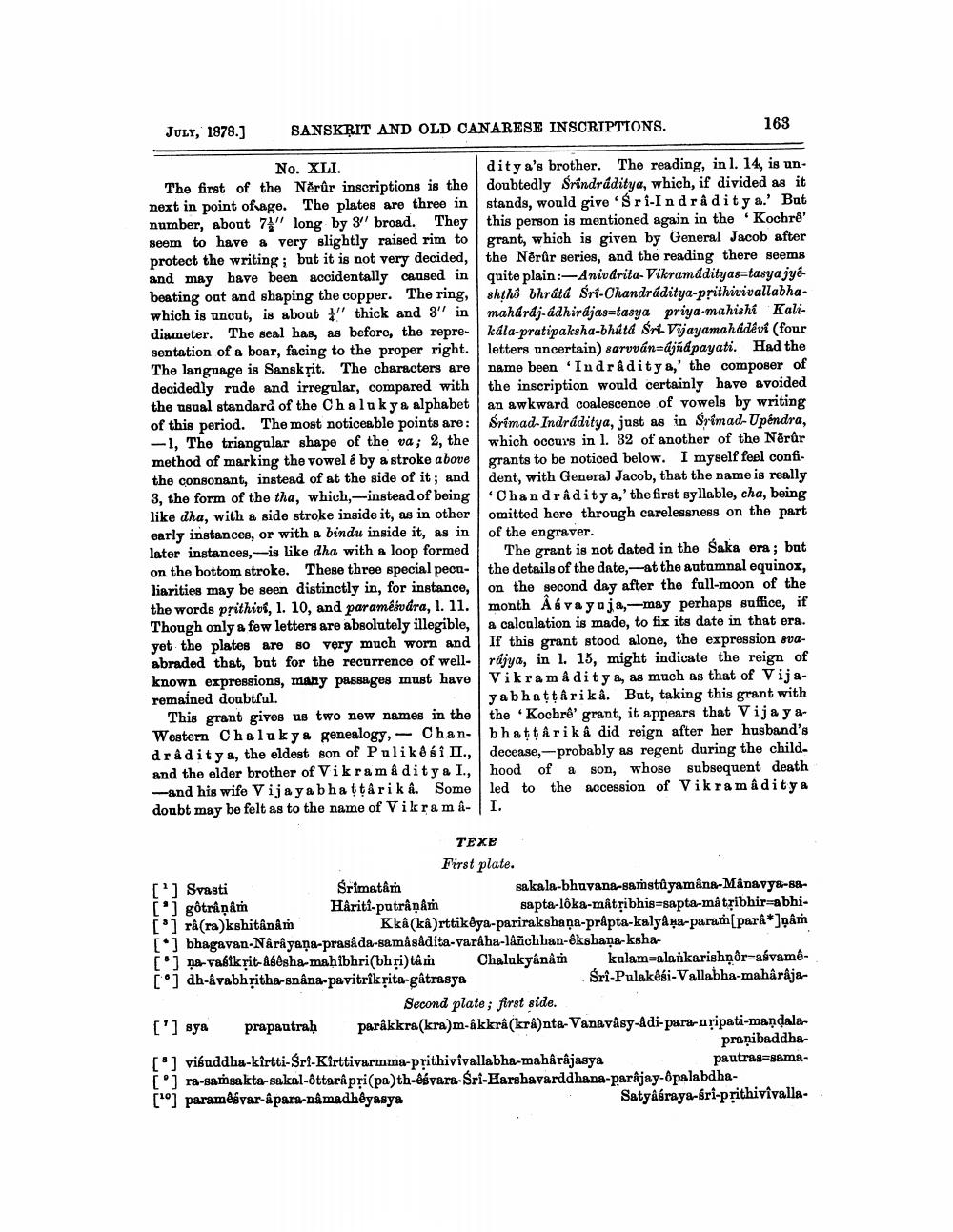________________
JULY, 1878.)
SANSKRIT AND OLD CANARESE INSCRIPTIONS.
163
No. XLI.
dity a's brother. The reading, in 1. 14, is un The first of the Nêrûr inscriptions is the doubtedly Srindráditya, which, if divided as it next in point of age. The plates are three in stands, would give 'Sri Indraditya.' But number, about 7" long by 31' broad. They this person is mentioned again in the 'Kochre' seem to have a very slightly raised rim to grant, which is given by General Jacob after protect the writing; but it is not very decided, the Nérür series, and the reading there seems and may have been accidentally caused in quite plain:-Anivdrita- Vikramadityas-tasya jyébeating out and shaping the copper. The ring, shtha bhrátá Śri-Chandráditya-prithivivallabhawhich is uncut, is about " thick and 3'' in mahardj.adhirajas-tasya priya-mahishi Kalidiameter. The seal has, as before, the repre- kdla-pratipaksha-bhita Sri-Vijayamahadevi (four sentation of a boar, facing to the proper right. letters uncertain) sarvván=djñdpayati. Had the The language is Sanskțit. The characters are name been 'Indr&ditya,' the composer of decidedly rude and irregular, compared with the inscription would certainly have avoided the usual standard of the Chalu kya alphabet an awkward coalescence of vowels by writing of this period. The most noticeable points are: Srimad- Indráditya, just as in Srimad-Upendra, -1, The triangular shape of the va; 2, the which occurs in l. 82 of another of the Něrůr method of marking the vowel é by a stroke above grants to be noticed below. I myself feel confithe consonant, instead of at the side of it; and dent, with General Jacob, that the name is really 3, the form of the tha, which,-instead of being Chandraditya,' the first syllable, cha, being like dha, with a side stroke inside it, as in other omitted here through carelessness on the part early instances, or with a bindu inside it, as in of the engraver. later instances,- is like dha with a loop formed The grant is not dated in the Saks era; but on the bottom stroke. These three special pecu- the details of the date,-at the autumnal equinox, liarities may be seen distinctly in, for instance, on the second day after the full-moon of the the words prithivi, 1. 10, and paramézvára, 1. 11. month As va yuja,-may perhaps suffice, if Though only a few letters are absolutely illegible, a calculation is made, to fix its date in that era. yet the plates are so very much worn and If this grant stood alone, the expression svaabraded that, but for the recurrence of well- rájya, in l. 15, might indicate the reign of known expressions, many passages must have Vikramaditya, as much as that of Vijaremained doubtful.
yabhattârika. But, taking this grant with This grant gives us two new names in the the Kocbrê' grant, it appears that VijayaWestern Chaluky& genealogy, Chan-bhattårikå did reign after her husband's dråditya, the eldest son of Pulikasi II., decease, probably as regent during the child. and the elder brother of Vikramaditya I., hood of a son, whose subsequent death -and his wife Vijayabhatt å rikâ. Some led to the accession of Vikramaditya doubt may be felt as to the name of Vikram &- I.
TEXE
First plate. ['] Svasti Srimatâm
sakala-bhuvana-samstůyamâna-Mânavya-88[') gôtråņam Hâriti-patrâņam
sapta-lôka-mêtribhis-sapta-mâ tribhir-abhi[°] rå(ra)kshitânâm
Kka(ka)rttik@ya-parirakshaņa-prâpta-kalyâha-param parâ*]ņâm [] bhagavan-Nârâyana-prasada-samâsâdita-varáha-lañchban-êkshana ksha[°] na-vabikțit-abesha-mahibhri(bhri)tâm Chalukyanam k ulam-alankarishạôr=asvamê[°] dh-avabhritha-snâna-pavitrikrita-gâtrasya
Sri-Pulakési-Vallabha-mahârâja
Second plate; first side. ['] sya prapautraḥ parâkkra(kra)m-akkrå (kra)nta-Vanavâsy-adi-paransipati-mandala
praņibaddha[') viénddha-kîrtti-Śrl-Kirttivarmma-prithivivallabha-mahârâjasya
pautrag=sama[°] ra-samsakta-sakal-Ottarapri(pa)th-eśvara-Sri-Harshavarddhana-parêjay-Opalabdha[*] paramébyar-apara-nâmadh@yasya
Satya-raya-bri-prithivivalla




